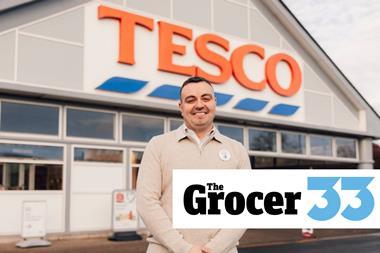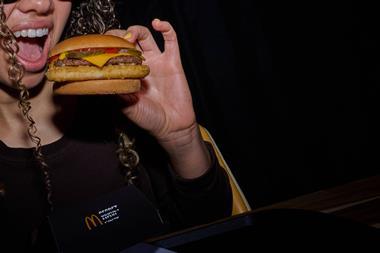The multiple is looking to new space and the web for extra shelf room, says Liz Hamson
Tesco insists it can strengthen its grip on the non-food market without eating into grocery food space.
Speaking at Citigroup Smith Barney’s annual food retailing conference last week, non-food commercial director Richard Brasher declared: “We won’t sacrifice food on the altar of non-food. Our first principle is to satisfy our food busines and our ambition is to expand on our space as and when planning permission is accomplished.”
The multiple has 45% of the supermarket sites with planning consent in the UK, according to the Competition Commission report. But planning constraints have forced it to look beyond its physical assets to grow its non-food business, revealed Brasher. “We are looking at the internet. We’re not in a hurry but we’re trying to find the right role, which we managed to find in grocery. It will be a material business for us in time - we strongly believe you have to be in a market to understand it.”
Brasher also signalled Tesco’s intent to steal market share from high street retailers. “The non-food market is fragmented and there are numerous models. We are very attracted to certain sectors,” he said. “We think our model is attractive and the high street expensive. Reducing prices is an attractive proposition.”
Underscoring Tesco’s commitment to EDLP, he continued: “When we talk to customers what they want is very straightforward. There are three things: convenience, low prices and added interest. We have 16 million transactions from 11 million customers a week and the non-food adds that element of interest and convenience. It’s a virtuous circle and the same one as with food - when you reduce prices, customers buy more and when you sell more there’s an opportunity to source products in a different way.”
One of those ways is directly. Tesco sources 70% of its clothing from overseas and plans to increase that to 90% over the next couple of years. It currently uses agents, but will gradually cut out the middlemen, confirmed Brasher. “To achieve lower prices you need to source direct, really direct. [Internationally] there are sourcing companies on the ground and our ambition
is to expand them further. Given that we trade in many of the countries ourselves already, it will give us an added advantage in terms of scale and volume.” Admitting that Tesco had initially “not taken seriously or understood” clothing, he credited clothing chief executive John Hoerner with “looking at clothing in the same way [as food] and significantly reducing prices without taking the quality out”.
Tesco has been particularly aggressive on price in the home entertainment arena, dropping the price of a CD from £15 to £9.87 in the past five years, building its market share from almost nothing to 16%. It was now identifying new areas of opportunity and, hinted Brasher, would ramp up its health and beauty offer next year. It also wants to drive further costs out of the supply chain. Since opening its Fastway RDC in Daventry, it has increased productivity and reduced lead times, he said.
Sainsbury told the Competition Commission that Tesco derived 73% of its profits from its non-food business this year and that by 2005 it would be making a loss on its food business.
Brasher brushed aside suggestions that Tesco had been cross-subsidising its food business with profits from its non-food business. But, he admitted: “The competition that is Wal-Mart has introduced a tension that makes margins thin and the oxygen low.”
As the oxygen is further depleted, how heavily will Tesco have to rely on non-food for breathing space?
Tesco insists it can strengthen its grip on the non-food market without eating into grocery food space.
Speaking at Citigroup Smith Barney’s annual food retailing conference last week, non-food commercial director Richard Brasher declared: “We won’t sacrifice food on the altar of non-food. Our first principle is to satisfy our food busines and our ambition is to expand on our space as and when planning permission is accomplished.”
The multiple has 45% of the supermarket sites with planning consent in the UK, according to the Competition Commission report. But planning constraints have forced it to look beyond its physical assets to grow its non-food business, revealed Brasher. “We are looking at the internet. We’re not in a hurry but we’re trying to find the right role, which we managed to find in grocery. It will be a material business for us in time - we strongly believe you have to be in a market to understand it.”
Brasher also signalled Tesco’s intent to steal market share from high street retailers. “The non-food market is fragmented and there are numerous models. We are very attracted to certain sectors,” he said. “We think our model is attractive and the high street expensive. Reducing prices is an attractive proposition.”
Underscoring Tesco’s commitment to EDLP, he continued: “When we talk to customers what they want is very straightforward. There are three things: convenience, low prices and added interest. We have 16 million transactions from 11 million customers a week and the non-food adds that element of interest and convenience. It’s a virtuous circle and the same one as with food - when you reduce prices, customers buy more and when you sell more there’s an opportunity to source products in a different way.”
One of those ways is directly. Tesco sources 70% of its clothing from overseas and plans to increase that to 90% over the next couple of years. It currently uses agents, but will gradually cut out the middlemen, confirmed Brasher. “To achieve lower prices you need to source direct, really direct. [Internationally] there are sourcing companies on the ground and our ambition
is to expand them further. Given that we trade in many of the countries ourselves already, it will give us an added advantage in terms of scale and volume.” Admitting that Tesco had initially “not taken seriously or understood” clothing, he credited clothing chief executive John Hoerner with “looking at clothing in the same way [as food] and significantly reducing prices without taking the quality out”.
Tesco has been particularly aggressive on price in the home entertainment arena, dropping the price of a CD from £15 to £9.87 in the past five years, building its market share from almost nothing to 16%. It was now identifying new areas of opportunity and, hinted Brasher, would ramp up its health and beauty offer next year. It also wants to drive further costs out of the supply chain. Since opening its Fastway RDC in Daventry, it has increased productivity and reduced lead times, he said.
Sainsbury told the Competition Commission that Tesco derived 73% of its profits from its non-food business this year and that by 2005 it would be making a loss on its food business.
Brasher brushed aside suggestions that Tesco had been cross-subsidising its food business with profits from its non-food business. But, he admitted: “The competition that is Wal-Mart has introduced a tension that makes margins thin and the oxygen low.”
As the oxygen is further depleted, how heavily will Tesco have to rely on non-food for breathing space?


















No comments yet